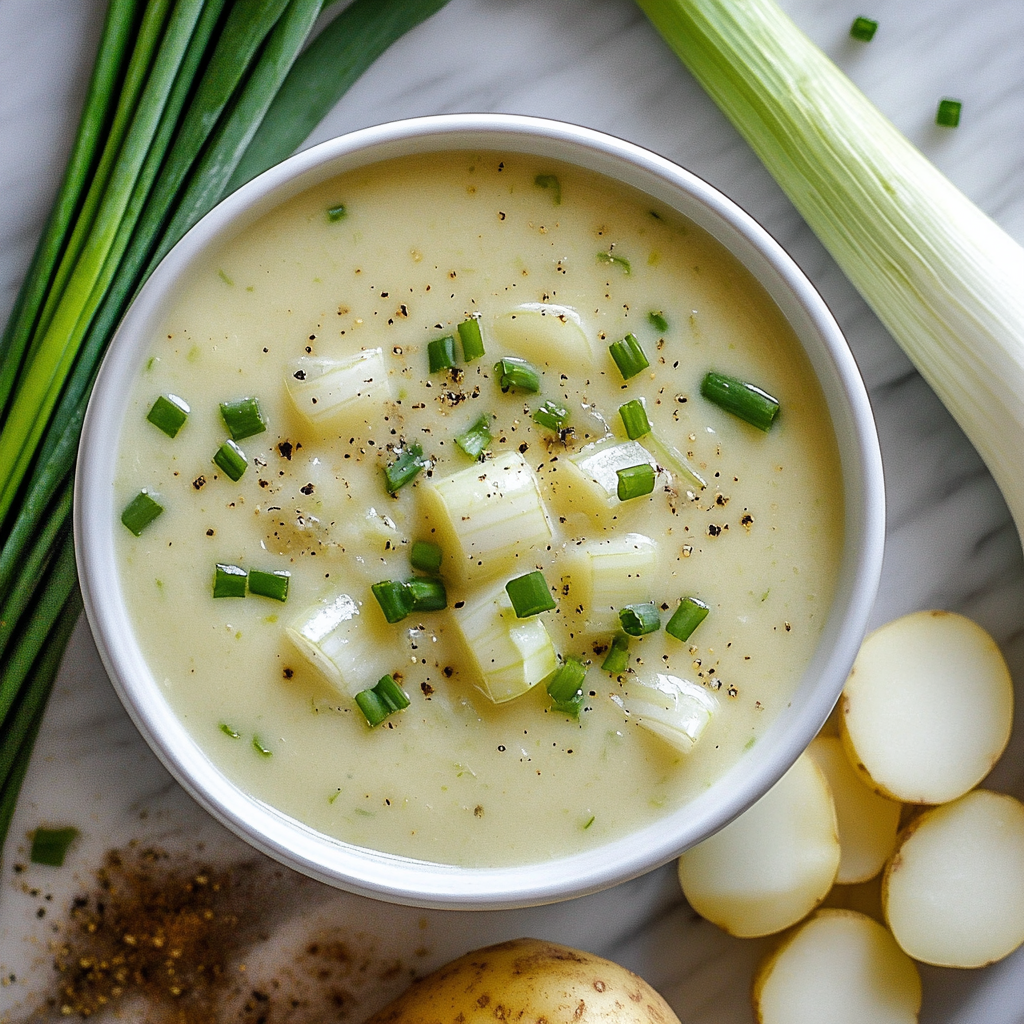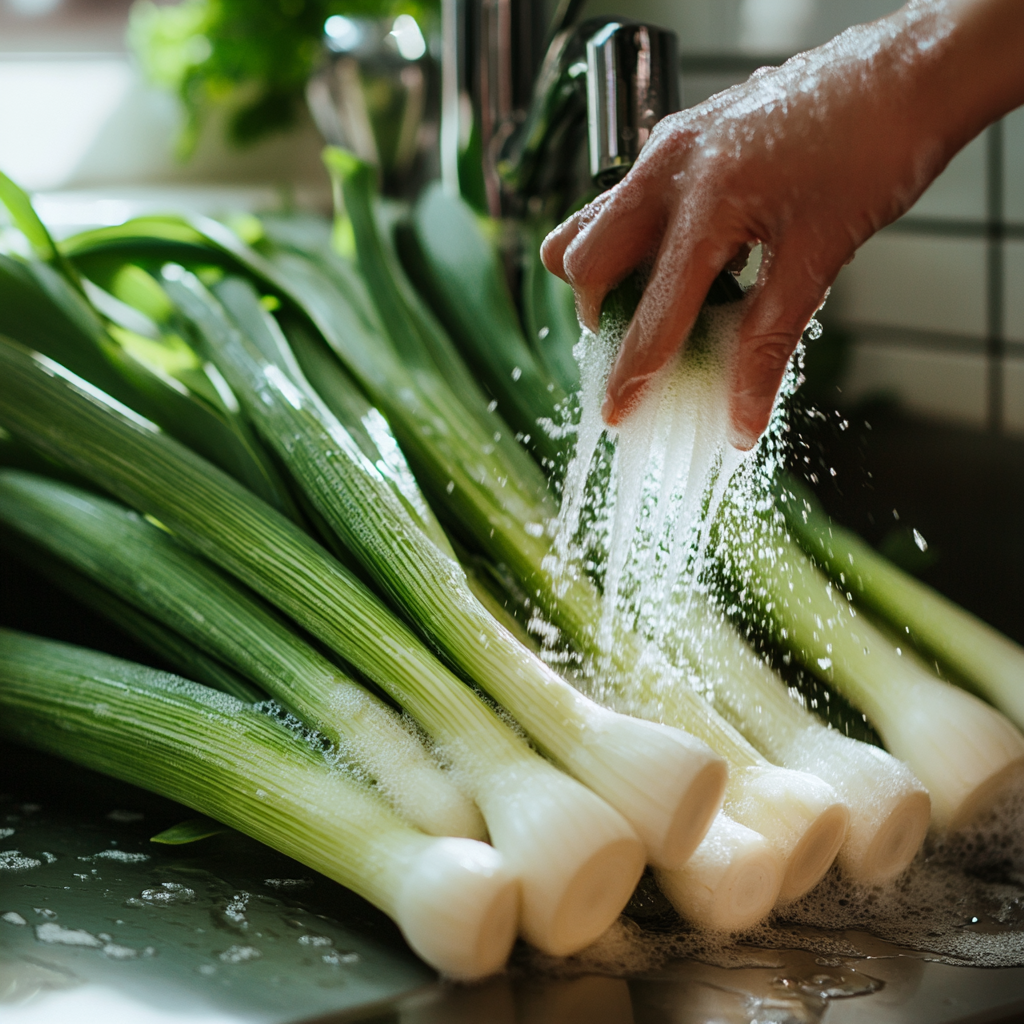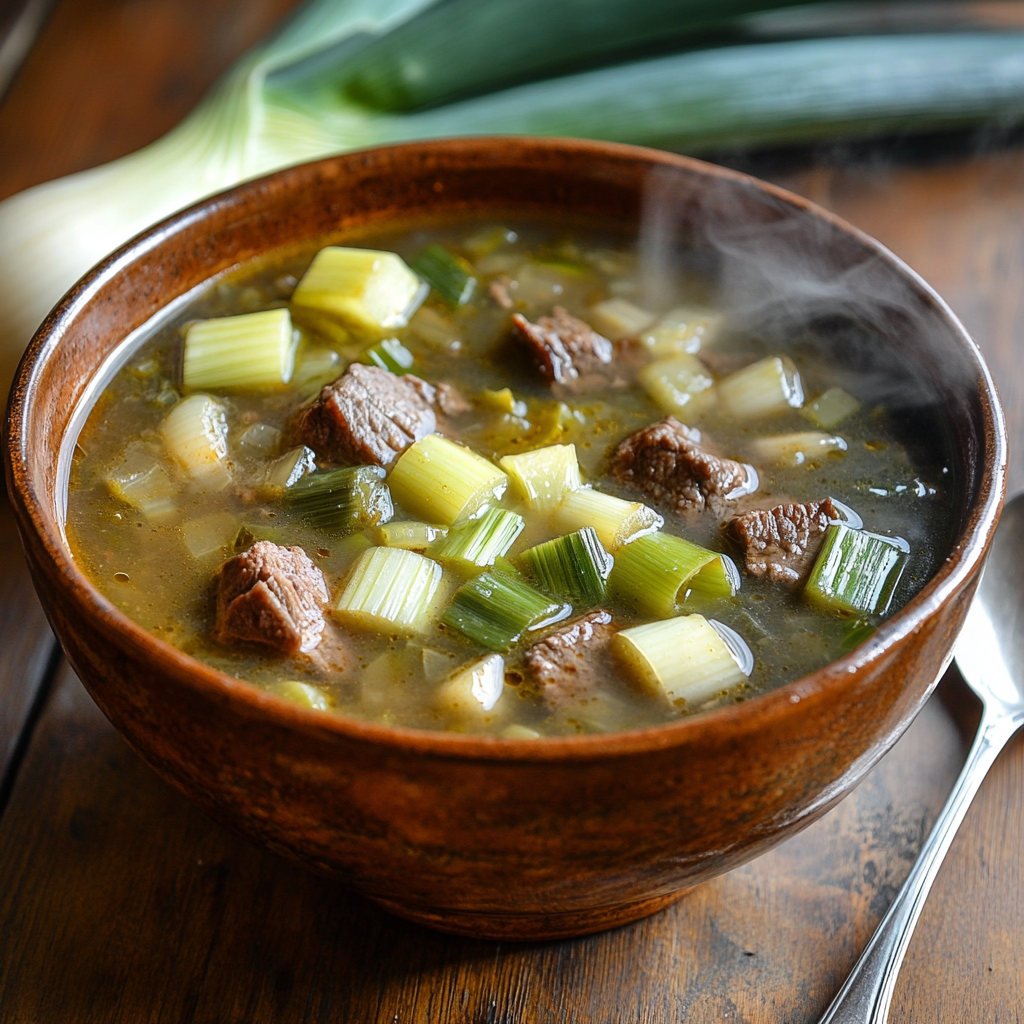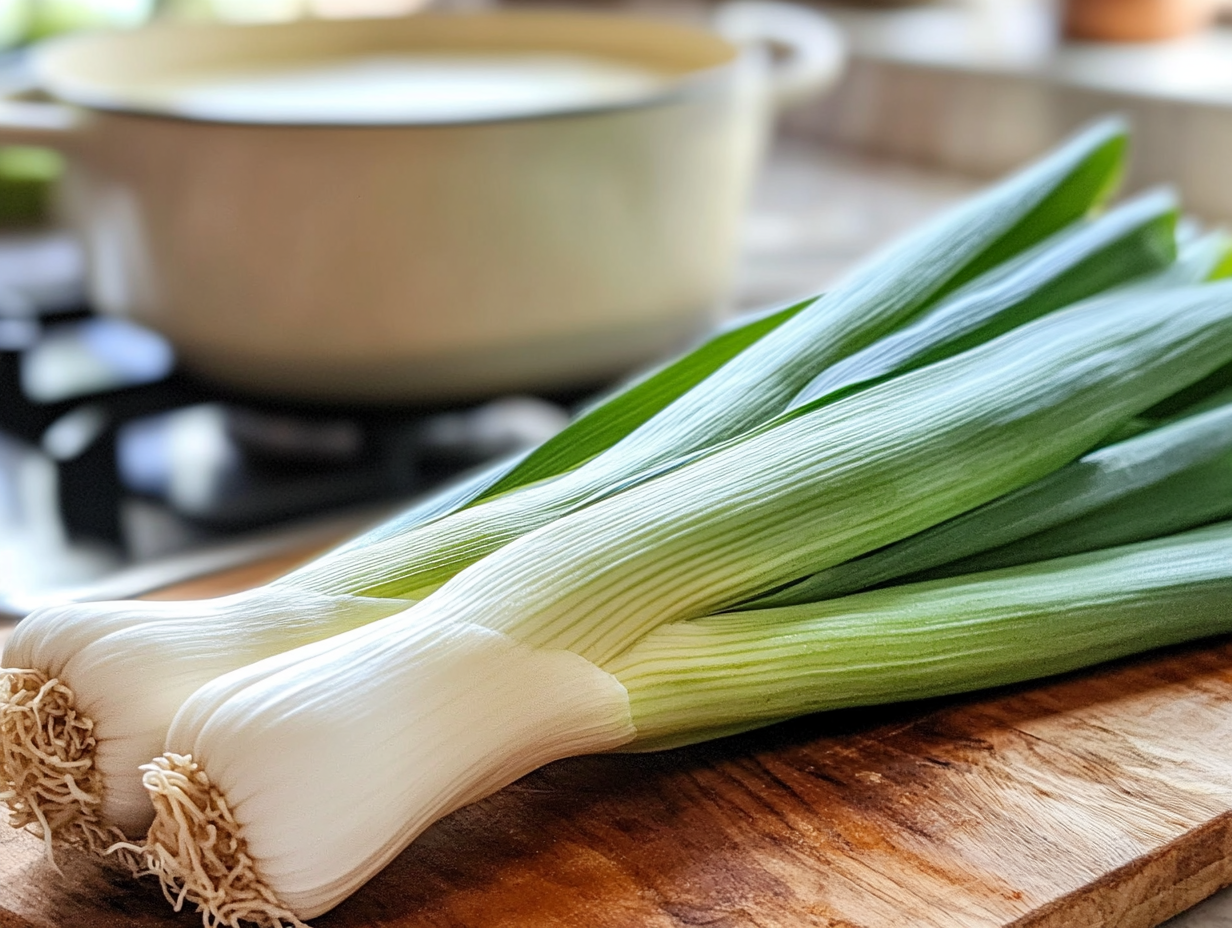Introduction
Leeks are an often-overlooked vegetable in the culinary world, yet they possess an extraordinary ability to transform a dish, particularly soups, into something that tantalizes the taste buds. But here’s the question many people ask: Which part of the leek is best for soup?
This vegetable, with its mild onion flavor and versatile texture, can add layers of complexity and richness to your soups. However, not every part of the leek serves the same purpose, and using the right part can elevate your soup to restaurant-quality status. Whether you’re aiming for a smooth, velvety broth or a chunky, hearty soup, choosing the correct part of the leek is critical.
In this article, we’ll delve into the anatomy of the leek, exploring the white bulb, light green stem, and dark green leaves, to discover which part is best for your specific soup recipe. We’ll also touch on some practical cooking tips and ways to maximize your leek usage.
Additionally, I will guide you through the proper cleaning and cutting techniques to ensure no dirt or grit ruins your soup. If you’re ready to master your leek skills and craft exquisite soups, let’s dive in!
For more leek-based inspiration, check out our Hearty Beef and Leek Soup Recipe for a perfect example of how leeks can transform a dish.
Understanding the Anatomy of a Leek
Leeks are divided into three main parts:
- The White Bulb: This is the portion of the leek that grows underground. It’s mild in flavor, soft in texture, and is most commonly used in soups.
- The Light Green Stem: This is the transitional area between the white bulb and the dark green leaves. It’s slightly tougher and more fibrous than the white part but contains more concentrated flavors.
- The Dark Green Leaves: Found at the top of the leek, these leaves are often discarded because of their fibrous texture, but they contain a deep, oniony flavor.
Each part of the leek can play a unique role in soup-making, depending on the recipe and the type of soup you’re making. Before we discuss the merits of each part in greater detail, let’s take a brief look at the leek’s overall culinary uses.
Leeks in Culinary History
Leeks have been cultivated for over 4,000 years, dating back to ancient Egypt and Mesopotamia. In fact, leeks were a favorite of the Egyptian pharaohs and are even depicted in ancient hieroglyphics. In Roman times, the leek was so highly esteemed that the Emperor Nero ate it daily, believing it would enhance his singing voice. Today, leeks are a staple in European, particularly French and British, cuisine, and they’ve made their way into kitchens worldwide.
Leeks are a member of the allium family, along with onions, garlic, and shallots, but unlike onions, leeks offer a more refined, subtle flavor. This makes them perfect for soups, where you want to impart flavor without overpowering the other ingredients.
Nutritional Profile of Leeks
Before deciding which part of the leek to use, it’s also worth understanding the nutritional value of this vegetable. Leeks are low in calories but rich in vitamins and minerals, including:
- Vitamin K: Supports bone health and blood clotting.
- Vitamin C: Enhances immune function and skin health.
- Vitamin A: Promotes good vision and skin health.
- Fiber: Aids in digestion and helps maintain healthy cholesterol levels.
- Antioxidants: The green parts of the leek are particularly high in antioxidants, which can help reduce inflammation and protect the body from oxidative stress.
Leeks are also packed with folate, which is essential for cell function and tissue growth. So, no matter which part of the leek you decide to use, you’ll be adding a dose of nutrients to your meal.
The White Part of the Leek: Your Go-To for Creamy Soups

The white bulb of the leek is the most commonly used part, and for good reason. Its delicate flavor, combined with its soft texture, makes it ideal for creating smooth, creamy soups. Whether you’re making a traditional potato and leek soup or experimenting with new recipes, the white part blends seamlessly into the broth, adding flavor without overpowering other ingredients.
The white part is mild and sweet, reminiscent of onions but with a more subtle and nuanced taste. This makes it a perfect choice for velvety purees and creamy soups. Because it cooks quickly, the white part doesn’t need much time to release its flavors and meld with the soup’s other ingredients.
Cooking Tip: How to Maximize the White Part’s Flavor
When using the white part of the leek, it’s best to sauté it in butter or olive oil before adding it to the soup. This will help caramelize the sugars, bringing out a richer flavor that can enhance the depth of your dish. After sautéing, add broth and allow the leeks to simmer until they soften completely.
To achieve a creamy texture, blend the white part into the soup with a stick blender. This technique works especially well for leek-based soups such as Leek and Potato Soup, where the goal is to create a smooth and luscious consistency.
The Light Green Part: An Often Overlooked Gem
Moving upwards, the light green stem of the leek is often dismissed in recipes, but this part offers excellent value, both in flavor and texture. While slightly tougher than the white part, the light green part contains a more concentrated leek flavor. This makes it perfect for brothy soups, where you want the vegetable to hold its shape without dissolving into the liquid.
Many home cooks discard the light green part, not realizing that it offers a unique contribution to soups. Because this part is firmer, it adds texture to chunkier soups, providing a nice contrast to softer ingredients like potatoes or beans.
Why the Light Green Part is Perfect for Chunky Soups
The light green part of the leek works well in hearty, chunky soups where a bit of bite is appreciated. Think of soups like chicken and vegetable soup or minestrone—dishes that rely on texture to make each spoonful interesting.
For example, if you’re making a hearty beef and leek soup, using the light green part adds an extra dimension to the dish, offering both flavor and texture. Try our Hearty Beef and Leek Soup Recipe to see how you can incorporate the light green part into a rich and filling meal.
Cooking Tip: How to Soften the Light Green Part
Because the light green part is tougher than the white bulb, it benefits from longer cooking times. Slow-cooking the light green part in broth will soften the fibers, making it easier to eat. If you’re short on time, you can also blanch the light green part before adding it to your soup, which will reduce the cooking time without sacrificing texture or flavor.
The Dark Green Leaves: A Secret Ingredient for Flavorful Stocks
The dark green leaves of the leek are often tossed aside due to their fibrous nature, but this part has a hidden talent: it’s perfect for making stock. While you may not want to chew through the tough leaves, they can impart a rich and deep flavor to your soup when used as a flavoring agent in broths or stocks.
The dark green leaves are loaded with flavor, much more so than the white bulb. By simmering them in water with other vegetables and herbs, you can create a flavorful base for any soup. Once the leaves have infused the broth, you can simply discard them before serving.
How to Make Leek-Infused Broth
Using leek leaves to make broth is easy. Simply chop the dark green tops into large pieces and add them to a pot of water with onions, garlic, celery, carrots, and herbs like thyme or parsley. Let everything simmer for at least an hour, and strain the broth to remove the fibrous vegetables. The result is a rich, savory broth that can serve as the base for your favorite soups.
This technique is especially useful when making large batches of soup. You can freeze the broth and use it later, ensuring you always have a flavorful base on hand.
Cooking Tip: Maximize the Flavor Without the Texture
If you want to use the dark green leaves in your soup without adding too much texture, try tying them into a bundle with kitchen twine before adding them to the pot. This way, they can infuse the broth with their flavor but can be easily removed before serving.
If you’ve ever wondered why your leek and potato soup lacks flavor, the answer may be in the preparation of the dark green leaves. Adding them to the stock base could make a significant difference. Find more tips on improving soup flavor in our article on Why Does My Leek and Potato Soup Taste Bland?.
How to Clean and Prepare Leeks for Soup

Leeks are known for being tricky to clean because dirt and grit often get trapped between their layers. Here’s a foolproof method for cleaning your leeks thoroughly, ensuring no unwelcome dirt ends up in your soup.
- Trim the Root End and the Dark Green Leaves: Start by cutting off the root end and discarding the dark green tops. Keep the white and light green parts for your soup.
- Slice the Leek in Half Lengthwise: This allows you to open up the layers and rinse away any hidden dirt.
- Rinse Under Cold Running Water: Separate the layers and wash thoroughly, making sure to remove all dirt. Even the smallest speck of dirt can ruin the texture of your soup.
For a more detailed guide, visit our comprehensive article on How to Clean and Cut Leeks for Soup.
Leek Recipes for Soup: Exploring Different Variations
While leek and potato soup may be the most well-known, there are numerous variations of soups that benefit from the flavor of leeks. Below are some recipe ideas to inspire your next culinary creation:
1. Classic Leek and Potato Soup
This is a traditional dish that highlights the mild, creamy flavor of the white part of the leek. It’s simple to make and requires just a few ingredients: leeks, potatoes, broth, and cream.
2. Chicken, Leek, and Barley Soup
The light green part of the leek shines in this hearty soup, which pairs perfectly with the tender chicken and chewy barley. The longer cooking time allows the leeks to soften and release their flavor into the broth.
3. Leek, Fennel, and Carrot Soup
This light, refreshing soup uses the white and light green parts of the leek, combined with the aromatic flavor of fennel and the sweetness of carrots. It’s perfect for a light lunch or appetizer.
4. Leek and Sweet Corn Chowder
The sweetness of corn pairs wonderfully with the delicate flavor of the white part of the leek. This creamy chowder is comforting and filling, ideal for colder days.

Conclusion: Choose the Right Part for the Right Soup
When it comes to soup, each part of the leek offers unique benefits. The white part is ideal for smooth, creamy soups, while the light green part adds flavor and texture to chunkier, brothy soups. And don’t forget the dark green leaves—they may be tough, but they’re perfect for creating a rich, flavorful stock.
No matter what type of soup you’re making, leeks can add depth and complexity to your dish. By understanding how to use each part, you can unlock the full potential of this versatile vegetable.
If you’re eager to experiment with leeks in your next dish, start by trying our Hearty Beef and Leek Soup Recipe, or learn more about how to improve your soups with leeks in our article on Why Does My Leek and Potato Soup Taste Bland?.

